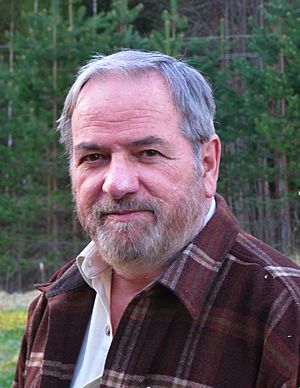John Deely facts for kids
Quick facts for kids
John Deely
|
|
|---|---|

John Deely (2009)
|
|
| Born |
John Nathaniel Deely
26 April 1942 Chicago, Illinois
|
| Died | 7 January 2017 (aged 74) Greensburg, Pennsylvania
|
| Alma mater | Saint Vincent College |
| Spouse(s) | Brooke Williams Smith |
| Era | 20th-/21st-century philosophy |
| Region | Western philosophy |
| School | Continental philosophy |
|
Main interests
|
Semiotics |
|
Influences
|
|
John Deely (born April 26, 1942 – died January 7, 2017) was an American philosopher. He was also a semiotician. This means he studied signs and how they work.
Deely was a professor of philosophy at Saint Vincent College in Latrobe, Pennsylvania. Before that, he taught at the University of St. Thomas (Houston). His main work looked at how signs help us understand the world. He explored how our experiences are like a web of connections made by signs.
He was the Executive Director of the Semiotic Society of America from 2006 to 2007. Many of his books were published in the Advances in Semiotics journal. One of his most famous books is Introducing Semiotics: Its History and Doctrine (1982).
Contents
About John Deely
His Education Journey
John Deely studied at the Aquinas Institute of Theology in River Forest, Illinois. He earned his Ph.D. (a high-level university degree) in 1967.
How He Shaped Semiotics
John Deely first learned about semiotics while working on language in Chicago. He read works by Jacques Maritain and John Poinsot. This led him to connect with Thomas Sebeok in 1968. Deely wanted to prepare a special edition of Poinsot's Tractatus de Signis (1632). This book was one of the first to deeply study signs. This project took 15 years to finish.
Deely and Sebeok became close friends. They helped start the Semiotic Society of America in 1975. Deely helped write the rules for this society.
In 1980, Sebeok asked Deely to manage the yearly reports for the society. Deely created a special writing style for these reports. This style focused on using dates from when a writer was alive. This helps show how ideas developed over time, like layers of rock show Earth's history.
Deely's 1982 book, Introducing Semiotics, was based on an essay he wrote in 1981. That essay won an award for the best essay in the field.
In 1990, Deely published Basics of Semiotics. Thomas Sebeok called it the "only successful modern English introduction to semiotics." Sebeok believed that 'semiotics' was the correct name for the study of signs. He thought 'semiology' was too narrow. Semiotics, for Sebeok, included signs in all living things, not just humans. This idea is now called biosemiotics.
Deely took this idea even further. He argued that signs also play a role in the physical universe, even before life began. He called this physiosemiosis. This idea suggests that the action of signs goes beyond living things. It explores how signs might have shaped the universe itself. Deely's Basics of Semiotics has been published in many languages.
In his 2010 book, Medieval Philosophy Redefined, Deely explored the "Latin Age." This period, from St. Augustine to John Poinsot, was the first time people really focused on signs. But then, philosophy shifted to studying how we gain knowledge (epistemology). This period was "cryptosemiotic," meaning the study of signs was hidden. Deely argued that Charles Sanders Peirce brought the study of signs back into the open.
In another 2010 book, Semiotics Seen Synchronically, Deely described semiotics as a modern field. He said Thomas Sebeok's work helped bring it all together.
His Personal Life
John Deely was married to Brooke Williams Smith. She is also a scholar who studies Jacques Maritain.
Deely was part of the Catholic Dominican Order.
More to Explore
- Charles Sanders Peirce
- John Poinsot
- Semiotic Society of America
- John Deely § Notes

